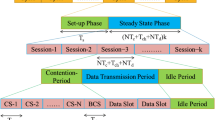Abstract
Present work proposes an Adaptive Bit-Map-Assisted (ABMA) Medium Access Control (MAC) protocol. ABMA is a modified form of Energy-efficient Bit-Map-Assisted (E-BMA) MAC protocol by which it can efficiently utilize the data slots with low overhead traffic. In ABMA MAC protocol, cluster head adaptively varies allotment of data slots to the sensor node (SN) which is based on the buffer status of the SN. In addition, ABMA uses two bit control field for the reservation of data slots and piggybacking. Simulation and mathematical models have been developed and proposed for ABMA MAC protocol. The performance of ABMA MAC protocol has been compared with Time Division Multiple Access (TDMA), Energy Efficient-TDMA (EA-TDMA), Bit-Map-Assisted (BMA) and Energy Efficient-BMA (E-BMA) MAC protocols. Both analytical and simulation results show the overall superiority of our proposed ABMA MAC protocol.








Similar content being viewed by others
References
Farag, H., Gidlund, M., & Sterberg, P. (2018). A delay-bounded MAC protocol for mission- and time-critical applications in industrial wireless sensor networks. IEEE Sensors Journal, 18(6), 2607–2616.
Akbar, M. S., Yu, H., & Cang, S. (2017). TMP: Tele-medicine protocol for slotted 802.15.4 with duty-cycle optimization in wireless body area sensor networks. IEEE Sensors Journal, 17(6), 1925–1936.
Siddiqui, S., Ghani, S., & Khan, A. A. (2018). ADP-MAC: An adaptive and dynamic polling-based MAC protocol for wireless sensor networks. IEEE Sensors Journal, 18(2), 860–874.
Lin, C. H., Lin, K. C. J., & Chen, W. T. (2017). Channel-aware polling-based MAC protocol for body area networks: Design and analysis. IEEE Sensors Journal, 17(9), 2936–2948.
Shafiullah, G., Azad, S. A., & Ali, A. B. M. S. (2013). Energy-efficient wireless MAC protocols for railway monitoring applications. IEEE Transaction on Intelligent Transportation System, 14(2), 649659.
Li, J., & Lazarou, G. Y. (2004). A bit-map-assisted energy-efficient MAC scheme for wireless sensor networks. In Third international symposium on information processing in sensor networks (pp. 55-60).
Hodge, V. J., OKeefe, S., Weeks, Michael, & Moulds, A. (2015). Wireless sensor networks for condition monitoring in the railway industry: A survey. IEEE Transactions on Intelligent Transportation Systems, 16(3), 1088–1106.
Shafiullah, G. M., Thompson, A., Wolf, P., & Ali, S. (2008). Energy-efficient TDMA MAC protocol for wireless sensor networks applications. In Proceedings of 5th ICECE, Dhaka, Bangladesh (Vol. 8590).
Pei, G., & Chien, C. (2001). Low power TDMA in large wireless sensor networks. In MILCOM proceedings communications for network-centric operations: Creating the information force (Vol. 1, pp. 347-351).
Ye, W., Heidemann, J. & Estrin, D. (2002). An energy-efficient MAC protocol for wireless sensor networks. In Twenty-First annual joint conference of the IEEE computer and communications societies (Vol. 3, pp. 1567–1576).
Heinzelman, W. B., Chandrakasan, A. P., & Balakrishnan, H. (2002). An application-specific protocol architecture for wireless microsensor networks. IEEE Wireless Communication Transaction, 1(4), 660670.
Chipcon, AS. (2004). An IEEE 802.15.4 Compliant and ZigBee-ready 2.4 GHz RF Transceiver. Microwave Journal. https://www.microwavejournal.com/articles/1633-an-ieee-802-15-4-compliant-and-zigbeeready-2-4-ghz-rf-transceiver.
Kaur, T., & Kumar, D. (2016). TDMA-based MAC protocols for wireless sensor networks: A survey and comparative analysis. In 2016 5th international conference on wireless networks and embedded systems (WECON), Rajpura (pp. 1–6).
Hsu, T.-H., & Yen, P.-Y. (2011). Adaptive time division multiple access-based medium access control protocol for energy conserving and data transmission in wireless sensor networks. Communications, IET, 5(18), 2662–2672.
Alvi, A. N., Bouk, S. H., Ahmed, S. H., Yaqub, M. A., Javaid, N., & Kim, D. (2015). Enhanced TDMA based MAC protocol for adaptive data control in wireless sensor networks. Communications and Networks, 17(3), 247–255.
Alvi, A. N., Bouk, S. H., Ahmed, S. H., Yaqub, M. A., Sarkar, M., & Song, H. (2016). BEST-MAC: Bitmap-assisted efficient nd scalable TDMA-based WSN MAC protocol for smart cities. In IEEE Access (Vol. 4, pp. 312–322).
Gangwar, M., & Kumar, R. (2017). An approach to improve BEST-MAC: Bitmap assisted efficient scalable TDMA-based MAC protocol using optimal cluster head selection. In 2017 2nd International Conference on Telecommunication and Networks (TEL-NET), Noida (pp. 1–5).
Author information
Authors and Affiliations
Corresponding author
Additional information
Publisher's Note
Springer Nature remains neutral with regard to jurisdictional claims in published maps and institutional affiliations.
Rights and permissions
About this article
Cite this article
Tolani, M., Sunny & Singh, R.K. Energy Efficient Adaptive Bit-Map-Assisted Medium Access Control Protocol. Wireless Pers Commun 108, 1595–1610 (2019). https://doi.org/10.1007/s11277-019-06486-9
Published:
Issue Date:
DOI: https://doi.org/10.1007/s11277-019-06486-9




